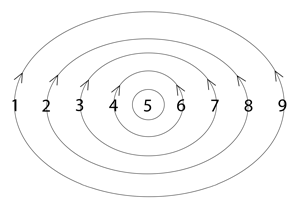abstract
2-1-3
Conventional Understanding
In conventional usage, “abstract” refers to ideas that exist primarily in thought rather than in concrete reality. We’re taught to see abstraction as the process of pulling away from sensory experience to form generalized concepts, believing that by creating such abstractions, we gain deeper understanding. Academic disciplines celebrate “abstract thinking” as superior to concrete observation, while businesses pursue “abstract models” to represent complex systems. This perspective creates an artificial separation between thought and reality, positioning abstraction as a mental achievement rather than recognizing it as a particular relationship to experience. This separation extends to how we view ourselves, encouraging us to identify with abstract self-concepts rather than direct experience.
Resonant Understanding
Mathematical analysis of language reveals “abstract” carrying a 2-1-3 resonance pattern, sharing this numeric signature with “intention,” “a false concept of self,” and “process of creation.” This places abstract at position 3 in creation’s sequence—the threshold point where potential begins to take form. Think of how water vapor becomes visible as fog. Abstraction represents the point where the invisible begins to take perceptible form but hasn’t yet fully manifested as tangible reality. When we observe children learning, we see them naturally moving from direct experience to forming conceptual understanding without the rigid categories adults later impose. They don’t separate “abstract thinking” from concrete reality, but experience both as a continuous flow.
Expressions Spectrum Analysis
When over-modulated, expressions include “abstract,” “circular movement,” and “future thinking,” revealing patterns corresponding with rigid conceptual frameworks that become trapped in self-reference. “Making claim” and “maintaining” show how over-modulation corresponds with attachment to conceptual structures and resistance to natural flow. “Fortress” and “lesson” reveal the defensive patterns that emerge when abstractions become fixed positions to defend rather than flowing perspectives.
Under-modulated expressions such as “abstract,” “sensory experience,” and “a false concept of self” demonstrate patterns of confusion and disconnection from authentic identity. “What am I” and “blocked giving” reveal the questioning and limitation that appear when this resonance pattern lacks clear direction. “Disengaged” and “limited perspective” show how under-modulation corresponds with failing to bridge potential and manifestation.
Beyond these expressions, words like “being state,” “realness,” and “process of creation” also share this resonance pattern, suggesting fundamental principles related to this pattern beyond modulation states. These uncategorized expressions point toward the authentic foundation that exists beneath the modulated expressions of abstraction.
Russell’s Cosmogony Connection
In the The Secret of Light Walter Russell describes reality as the product of Mind thinking, where thought directly manifests as experience:
“God is Light. God is Universal Mind. Mind is Light. Mind knows. Mind thinks what it knows. Mind thinks in two opposed lights simultaneously projected from their centering white Light and sequentially repeated in cycles.”
This principle relates directly to how abstraction functions at position 3—the threshold where Mind’s thinking begins to take form. The 2-1-3 pattern represents the point where universal desire begins to manifest through intention, but before it enters full conscious experience.
In A New Concept of the Universe, Russell elaborates: “The basis of all the periodic tables is the cube. It is the measure of all motion.” This geometric principle demonstrates how abstract mathematical relationships underlie all manifest reality—the cube represents the structural pattern through which Mind’s thinking manifests as form.
Practical Implications
Understanding abstraction as a threshold phenomenon transforms our relationship with conceptual thinking. Rather than seeing abstractions as separate from reality, we might recognize them as the visible fog forming at the boundary where Mind’s thinking begins to take perceptible form.
In education, this insight challenges the hierarchy that places abstract thinking “above” concrete experience. Instead, we might foster environments where children naturally move between direct experience and conceptual understanding without creating artificial separations. A child building with blocks is simultaneously engaging with concrete objects and abstract mathematical principles—there is no separation until we impose one.
This understanding also illuminates how a “false concept of self” emerges when the natural flow of intention becomes modulated. Rather than identifying with abstract self-concepts, we might recognize our authentic identity as an expression of Mind’s intention flowing naturally through position 3. This liberates us from the circular trap of abstract identity, allowing us to experience ourselves as dynamic expressions of creative flow rather than fixed conceptual entities.
In technology, this perspective reveals how virtual reality based on abstract concepts creates fundamental limitations, offering only modulated sensory experience rather than the full spectrum of reality that emerges through balanced intention. By recognizing abstraction as a modulated expression rather than as reality itself, we can avoid becoming trapped in conceptual systems that reference only themselves rather than connecting to the unified field of Mind thinking.


